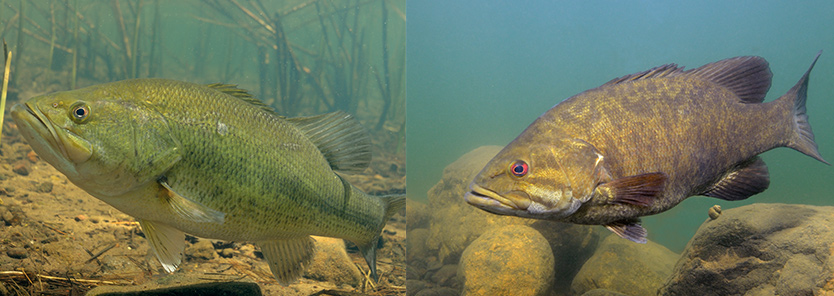Largemouth and smallmouth bass. While there are many differences between these two bass species, there are also a lot of similarities. One of the main questions is; “How do you tell them apart?” The quickest way is to look at how far their mouth extends back. The back of the mouth extends well beyond the eye when viewing a largemouth’s profile, while the mouth of a smallmouth bass will stop about even with the middle of its eye.

Largemouth Bass
The largemouth bass (Micropterus salmoides) is a freshwater game fish also in the sunfish family, a species of black bass native to North America.
It is known by a variety of regional names, such as “wide-mouth bass,” “bigmouth bass,” “black bass,” and “bucket-mouth.” They are marked by a series of dark, sometimes black (but sometimes not so dark), blotches creating a jagged horizontal band along their lateral line, down their side.
The largemouth bass is the state fish of Georgia, Mississippi, and Indiana, the state freshwater fish of Florida and Alabama, and the state sport fish of Tennessee.
Juvenile largemouth consume small bait fish, fresh-water shrimp and insects. Adults consume smaller fish bluegill, crappie, shad, snails, crawfish, frogs, snakes, salamanders, even small water birds, mammals, and baby alligators. Prey items can be as large as 50% of their own body length or larger!
The world record largemouth was caught from Montgomery Lake in Georgia and weighed 22 lbs 4oz.
Smallmouth Bass
The smallmouth bass (Micropterus dolomieu) is a freshwater species in the sunfish family. It’s a popular game fish throughout the temperate zones of our continent, and has been spread by stocking to many cool-water tributaries, lakes and reservoirs.
A smallmouth is often also called a “bronzeback,” “brown bass,” or “smallie.” And is generally brown with red eyes, and dark brown vertical bands, where a largemouth has a horizontal band along its side. Males are usually smaller than females – males are usually about 2 to 2.5 pounds maximum, while females can range from 3 to 6 pounds or more. Their sizes can vary depending on where they are found. In American waters they are likely to be larger because of a longer summer, which means they can eat and grow for a longer.









